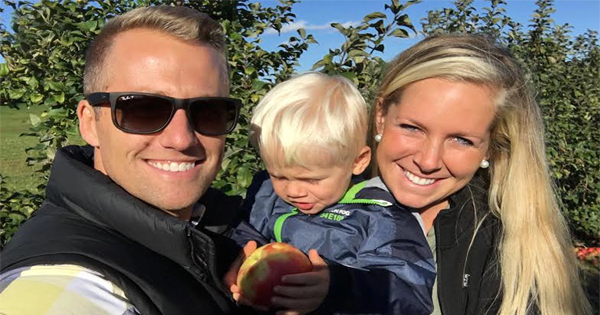Ever since Anna Weeber was 16 years old, she’s been suffering from frequent, terrible headaches. Each week, she’ll have about three migraines but over the past 11 years, she’d gotten accustomed to dealing with their pain.
On one September afternoon however, when Anna was 27 years old, as she got dressed to go on a bike ride with her husband and two-year-old son, Declan, she was struck down by a headache that was worse than any she’d ever experienced.
“It was the most intense headache I’d ever had in my life,” she recalled. “It felt like a balloon was filling with tar in my head.”
She tried first to ride out the agony, but soon enough, the pain had her sweating and vomiting. Her husband, Nate, dialed 911 just as Anna realized she had lost control over the left side of her body.
After that, she remembered little else of the incident.
Anna was rushed to the hospital, where doctors confirmed with a CT scan that her intense headache was actually a ruptured brain aneurysm, during which a blood vessel swells until it explodes. The blood that’s released then fills in the spaces around the brain, potentially causing a fatal stroke.
Dr. Justin Singer, Director of Vascular Neurosurgery at Spectrum Health where Anna was sent, explained that about half the patients who have ruptured brain aneurysms don’t make it to the hospital alive. Of the half who does make it, almost half of them “don’t recover to their previous level of health and function.”
When Dr. Singer came onto Anna’s case, however, he was determined to beat the odds and statistics stacked against her. She was about the same age as his wife, and both women were 24 weeks pregnant at the time. Dr. Singer wanted desperately to save both her and her child’s life.
At the hospital, Dr. Singer called on the help of a maternal fetal specialist to assess Anna’s condition and determine how to best save both mother and child’s life. They ultimately determined that they would need to perform brain surgery to insert a clip to isolate the aneurysm from the rest of Anna’s circulatory system to remove it most cleanly.
From the moment Nate knew his wife and unborn child would be going into surgery, he asked for prayers on Facebook. His story was shared across the globe and soon enough, the family was receiving support from all over.
Late that night, 20 hours after Anna’s aneurysm, Dr. Singer reported that Anna’s surgery was successful. She was “completely back to herself,” Nate reported.
But for the next 18 days, Anna remained in the hospital so doctors could treat her for vasospasms, a common complication that limits blood flow in the brain and arises after brain aneurysms. They can cause further stroke-like symptoms or even paralysis and death.
Thankfully, Anna was able to be safely and effectively treated, and she even returned home in time to go apple picking and do “all of the normal fun fall activities” with her family.

Finally, on December 30, 2016, Anna gave birth to her second child, a son she and Nate named Hudson.
The family prayed for the longest time that Hudson wouldn’t exhibit any lasting effects of Anna’s stroke or subsequent surgery and to their immense relief, “he is one perfectly healthy little boy.”
“The first couple of days after Hudson was born, [Nate] and I would look at each other and make eye contact and I would just start crying knowing everything we’ve been through together,” Anna said.
As for Dr. Singer, he and his wife welcomed their child just a week after Hudson’s birth, and the two families have already met up with their respective children to have a play date.
Anna is now looking forward to spending the rest of her life with her family. She is relieved to report that her headaches have completely stopped. The only other noticeable change is that she’s begun snoring. “My husband is totally fine with the snoring considering that of all the possible outcomes I’m here and alive,” she laughed.





